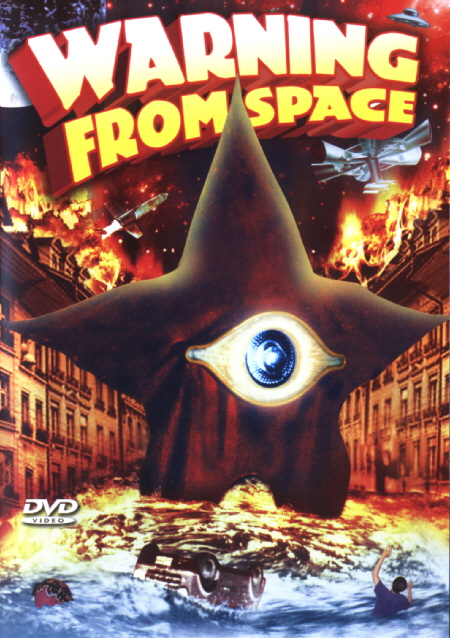- Warning from Space
Infobox_Film
name = Warning from Space (Uchūjin Tokyo ni arawaru)

caption = DVD cover for "Warning from Space" (1956)
director =Koji Shima
producer =Masaichi Nagata
writer = Gentaro Nakajima (novel)
Hideo Oguni (screenplay)
Jay Cipes (English dialogue)
Edward Palmer (English dialogue)
starring = Keizo Kawasaki
Toyomi Karita
Bin Yagasawa
Shozo Nanbu
Bontarô Miyake
Mieko Nagai
Kiyoko Hirai
Isao Yamagata
music = Seitaro Omori
cinematography = Kimio Watanabe
editing = Toyo Suzuki
distributor = Daiei
released =January 29 ,1956 JPN
runtime = 88 min. (US version)
language = Japanese
budget =
imdb_id = 0049900nihongo|"Warning from Space" or "Mysterious Satellite"|宇宙人東京に現わる|Uchūjin Tokyo ni arawaru|Spacemen Appear in Tokyo is a
1956 science fiction tokusatsu film produced by Daiei, and the firstJapan ese science-fiction film produced in color. The plot of the American English-dubbed version is somewhat similar toToho 's later nihongo|"Gorath "|妖星ゴラス|Yosei Gorasu (1962), depicting a planet — "Planet 'R'" — on acollision course withEarth . "Warning from Space" has one-eyed, starfish-shaped aliens from the planet Paira who take on human forms to warn the earth about the impending disaster. In contrast to the usual anti-nuclear message of the Japanese science-fiction film genre, "Warning from Space" seemingly takes the position that nuclear weapons can be put to good use, as a means to prevent the collision with Planet 'R.'The Pairan aliens were designed by prominent avant-garde artist, Taro Okamoto. Walt Lee reports that Gentaro Nakajima's novel, on which this film was based, was in turn based on the Japanese folktale "Kaguya-hime". [cite book|author= Lee, Walt (Compiler)|year=1974|title=Reference Guide to Fantastic Films: Science Fiction, Fantasy, and Horror|publisher=Chelsea Lee Books|location=Los Angeles|id=ISBN 0-913974-04-8 ] However, it is difficult to see much connection between the film and the folktale.
Produced during the science-fiction boom following in the wake of the success of
Toho 's "Godzilla" (1954), Daiei had hoped to find a foreign market for "Warning from Space." [Shoemaker, Greg (1979). "Daiei: A History of the Greater Japan Motion Picture Company." "The Japanese Fantasy Film Journal" Number 12. p.14. ] The film played at the King Cinema in Rangoon in January 1958, earning 11,846 kyat during its first week. ["Far East Film News".January 17 ,1958 . p.21. ] However Daiei was unable to find an international distributor for the film until American International purchased it for U.S. TV about 1965.Footnotes
Cultural influence
The Star Conqueror,
Starro , a villainous character ofDC Comics that is a giant starfish-like creature can be seen as an ironical twist in the concept of the pacific aliens from Paira. Possessing mind control abilities, Starro wishes to create "calm and order" by enslaving the psyches of other beings within aGroup mind (science fiction) . It was created in 1960 in the first apparition of theJustice League of America "So much so even that in 1956, in order to try and sucker potential viewers into seeing their new sci-fi disaster pic Warning From Space, they went so far as to create a promotional poster for the movie that included art of a giant starfish monster (that bears a striking resemblance to DC Comics’ Justice League villain Starro the Conqueror, who would be created four years later" [http://www.tombofanubis.com/Reviews/A/WarningFromSpace.html ]References
External links
* [http://www.digitalmonsterisland.com/warning_from_space.html Warning From Space] at Digital Monster Island (Review of the DVD)
*imdb title|0049900|title=Uchûjin Tokyo ni arawaru
*
Wikimedia Foundation. 2010.
